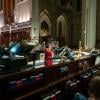
On a colder-than-usual Los Angeles night with a harrowing street-parking situation and an unmarked venue to locate, one might expect flaky concert attendance — but Monk Space was spectacularly packed for Brightwork newmusic’s 10th-anniversary concert on Saturday. And why should it not have been? Brightwork has grown to become a vital fixture of the L.A. new-music scene over the past decade, actively premiering and commissioning new works, nurturing a repertoire of 20th- and 21st-century “classics,” and captivating in-the-know concertgoers with its (increasingly less) underground concert series, Tuesdays @ Monk Space.
Fittingly, the theme of Saturday’s show was the story of Brightwork itself. Between pieces, founder and pianist Aron Kallay and percussionist Nick Terry dribbled out bits of Brightwork lore and made poignant dedications to members of the community, drawing explicit connections between the music and the people behind it.

Three of the night’s six featured composers were even in the audience. Chinary Ung had a front-row seat to … Still Life After Death, his stirring theatrical work inspired by a Cambodian deathbed ritual. Soprano Stacey Fraser gave a haunting, well-acted performance that began with full-throated shrieks and ended with strained, dying croaks as she duetted with guest bass Dylan Gentile. When the full ensemble was playing, most of Fraser’s vocals were regrettably lost in the mix, unable to compete with the power of the other instruments.
Blame the frequently uneven balance of the room. Monk Space is a cool-looking venue, but its mainstage isn’t particularly conducive to acoustic equality among strings, winds, vocals, and percussion. Brightwork’s in-house chamber group is a Pierrot ensemble — two strings, two winds, one piano (as in Arnold Schoenberg’s Pierrot lunaire) — with added percussion and soprano, but the mix at Monk Space too often emphasizes the individual woodwind and percussion instruments at the expense of the overall blend.
Acoustically speaking, the best-sounding piece of the night was Pamela Madsen’s “A Prayer For My Daughter” (from her chamber opera Why Women Went West). Madsen, who introduced the work herself, wrote the opera specifically for Brightwork and Fraser, making it another important touchpoint in Brightwork lore. Fraser’s earnest stage presence was once again delightful to watch, her sung and spoken voice finally able to project warmly above a cohesive blend of piano, violin, and cello (sans flute, clarinet, or percussion).
Rajna Swaminathan introduced The Illusion of Permanence as being about the process of remembering a song from her childhood — “Pyaare darshan dijo ay.” Fraser sang wistful melodies over a bed of gossamer textures and oscillating fragments, while a modified drum kit tried to ramp up momentum (never fully managing to maintain energy). Eventually, the players put down their instruments and joined Fraser in song, harmonizing a cappella as they exited the room through the audience, ending the piece offstage.
Saturday’s performance was a world-premiere arrangement of Swaminathan’s work, which was originally composed for chamber ensemble, voices, and mrudangam (an Indian percussion instrument). I have no doubt that the original version is better; without the buoyant agility of the mrudangam, the bespoke Brightwork arrangement felt like a compromise of the composer’s ideal vision.

In the second half, Terry paid touching tribute to the late composer Shaun Naidoo (1962–2012) — one of the group’s first collaborators — and dedicated Naidoo’s Ararat (“a challenging, dastardly score”) to those no longer with the Brightwork community. Another longtime collaborator, Adam Borecki, wasn’t able to attend the concert, but he proved Kallay’s introduction (“He’s a fun, cool composer”) true with the humorous melodica surprise at the end of his piece Scorpio.
Kallay saved the best story for last with his introduction to The Glam Seduction, D.J. Sparr’s Van Halen-inspired work. This was one of the first pieces in Brightwork’s repertoire 10 years ago, but apparently, the group was ill-prepared for that first performance; Kallay has wanted another crack at it ever since then. On Saturday, these musicians exuded fun, shredding their hearts out with flashy solos, anthemic electric drums, and profuse expressions of cowbell. Brian Walsh had the last say with a frizzy, bendy, wailing tenor sax solo that brought on quick applause before the cake and revelry that followed.




